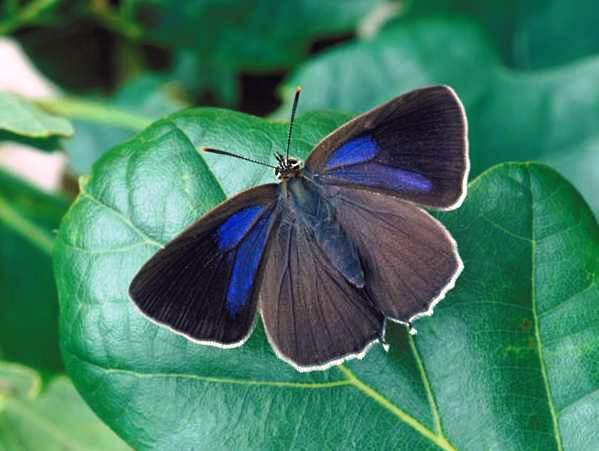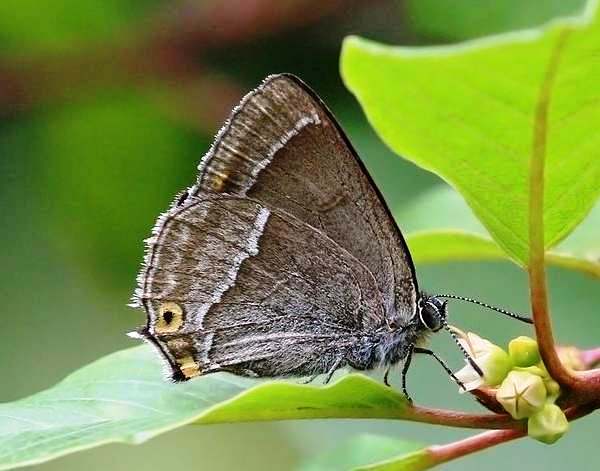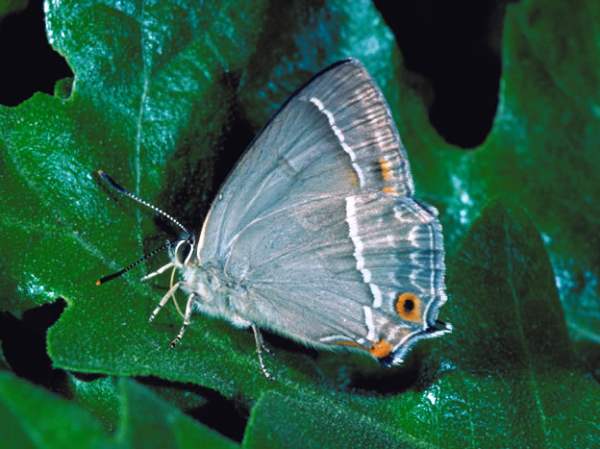Trees Birds Mammals Fish Amphibians Reptiles
Wild Algarve
Bookshop
Purple Hairstreak Butterfly - Favonius quercus
Phylum: Arthropoda - Class: Insecta - Order: Lepidoptera - Family: Lycaenidae

The Purple Hairstreak is the commonest of the hairstreak butterflies recorded in Britain; however, because they spend most of the time high up in the canopy of oak woodland it is not easy to get to see these lovely butterflies,
Identification
Pictured above is a female, which has two purple patches on the forewing only. Males have a glossy purple sheen on the upperside of both their forewings and their hindwings. The underside is light grey with a white streak, edged in black, running down both wings. There are two short tails on the hindwings, with two orange spots at the base on the underside.
Habitat
Purple Hairstreak butterflies inhabit oak woodlands, particularly in southern Britain but also locally further north. (The specific epithet quercus means 'oak'.) Because of their habit of flitting back and forth high up in the canopy, the Purple Hairstreak is rarely seen clearly except during one of its occasional excursions to low bushes or scrub on a woodland edge, ride or clearing.

Distribution
In Britain the Purple Hairstreak is most commonly found in southern England and South Wales, but it does occur, although less frequently, in southern and central mainland Scotland. In Ireland this species is also most common in southern counties..
Elsewhere, on mainland Europe, Purple Hairstreaks are recorded from most countries from Scandinavia down to the Mediterranean; this species is also found in parts of north Africa.
Lifecycle
In summer the eggs, looking rather like miniature Sea Urchins, are usually laid singly on the bases of Oak buds. Oaks arethe foodplants used by larvae (caterpillars) of the Purple Hairstreak. The caterpillars develop very quickly within the eggs but then remain there in a dormant state, overwintering until the following spring.
In the spring, stout brown pupae, typically 1cm long, form either just below the soil surface or beneath leaf litter, moss or tree bark. After about four weeks as pupae, a single brood of adults emerge from late June through into August.

Acknowledgements
This page includes pictures kindly contributed by Rob Petley-Jones and by the Countryside Council for Wales (CCW).
Studying butterflies and moths...
Excited by rivers and streams? So are we, and we're pretty sure you would find the Winding River Mystery trilogy of action-packed thrillers gripping reading too. Dead Drift, Dead Cert, and Dead End are Pat O'Reilly's latest river-based novels, and now they are available in ebook format. Full details on our website here...
Buy each volume in ebook format for only £2.47 on Amazon... Paperbacks also available on Amazon at £6.95 each. All proceeds go towards keeping the First Nature website online.
Please Help Us: If you have found this information interesting and useful, please consider helping to keep First Nature online by making a small donation towards the web hosting and internet costs.
Any donations over and above the essential running costs will help support the conservation work of Plantlife, the Rivers Trust and charitable botanic gardens - as do author royalties and publisher proceeds from books by Pat and Sue.